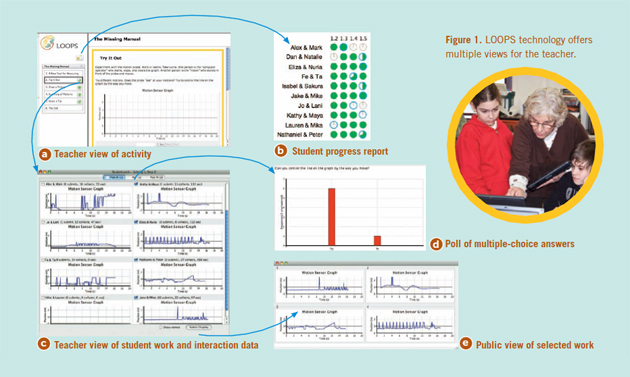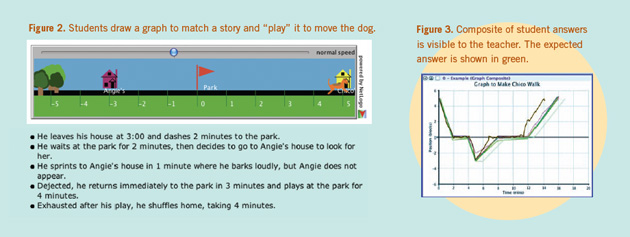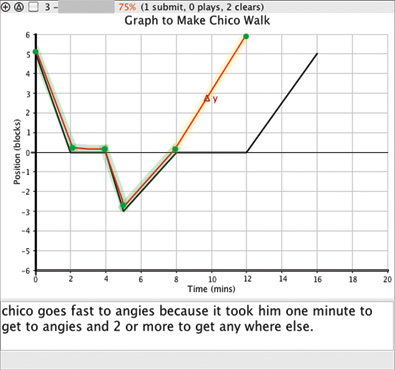LOOPS Offers a Lens on Learning
Imagine you are a student. Your teacher gives you a handheld instrument, but the instructions for using it are lost! You’re told that it displays a graph of position vs. time when plugged into your computer, and you’re asked to take some measurements. What would you do?
Groups of students were given the chance to find out. They were given these instructions and a motion probe as they embarked on “Missing Manual,” the first activity in the motion and graphing curriculum developed by the LOOPS (Logging Opportunities in Online Programs for Science) project. There are known challenges for teachers engaging their students in this kind of independent learning. LOOPS has been investigating how best to address these challenges.
The Missing Manual activity is one of four activities developed by the LOOPS project that challenge students to think like scientists and experiment freely to gain skills in independent problem solving. As students progress through the activities, they learn how to graph a motion story on position vs. time graphs, define a frame of reference, explain the difference between position and distance, and calculate the speed of an object from a graph of its motion.
Addressing different learners
Curricula such as Missing Manual, in which students are cut loose to investigate on their own, have been tried for decades. While appealing to a certain type of student, others may not know where to begin and may become frustrated. This curricular approach, however, offers the potential to develop independent investigation skills, as long as students are given the support they need.
Funded by the National Science Foundation, LOOPS is researching how teachers can best monitor and support diverse student learning using instantaneous electronic feedback about each student’s investigations and thinking. We believe that the classroom can be a community of learning mediated by the teacher, with individualized scaffolding for each student. Sixth-grade students in two suburban Boston middle schools helped us test this hypothesis. In the Missing Manual activity, they used a motion probe, a wirelessly connected laptop computer, and software that embeds probes and models into online activities.

Modeling a scientific community
After students had a chance to play with the motion probes and get a sense of how they work, the teacher brought the class together to share what they had done and to discuss what they had learned. The students had different ideas about how the probe measured motion. Several students advocated for the idea that the probe measured back-and-forth motion, while some thought it measured side-to-side motion, and others, up-and-down motion or even a combination of motions. The teacher projected some of the graphs and explanations on a screen at the front of the class and engaged the students in a discussion. Let’s listen in on part of that discussion between the teacher (T) and one of her students (S):
T: (Pointing to where the position vs. time graph line goes up.) Am I going toward the probe or away from the probe?
S: Away.
T: (Pointing to where the line goes down.) Then, what’s here?
S: Closer to the probe.
T: (Pointing at the next incline of the line.) Then I jumped right here. If this is going away, why is that jumping? What’s the difference?
S: Going away it goes up, and jumping…
T: Do you think when you jump it goes up, too?
S: Yeah.
T: (Turns to the class.) Okay, can we test that? How many people think it goes up when you’re jumping? What kind of a line do you get when you jump?
With student work and discoveries as the focus of classroom discussions, as in the above exchange, the class is transformed into an authentic scientific community in which experimenters test and examine the validity of scientific claims, sharing data in order to make sense of it and to examine hypotheses about how things work.
These class discussions are opportunities for students to cast a critical eye on data and ideas. The discussions also serve to reignite experimentation or bring closure to the big topics in the curriculum.
LOOPS enhances the classroom experience by enabling these discussions to take place in real time. There is little lag between student experimentation and community examination of results.

Viewing student progress in real time
Students complete activities on their computers using instruments such as motion probes. They submit their predictions, data, observations, and reflections to the teacher’s machine in real time using a local wireless network. Using LOOPS technology on a mobile tablet computer, the teacher receives that data while circulating throughout the classroom observing individual student work. LOOPS enables teachers to work closely with student groups as well as with individual students with different learning styles.
With this wealth of information a teacher can pinpoint individuals who may need assistance. She also can share student work with the class — anonymously if she chooses — by displaying selected work on a classroom projector.

Figure 1 shows examples of information available to a teacher in the Missing Manual activity. The teacher can view the activity (Figure 1a) and see how far students have progressed by looking at pie charts that represent the fraction of steps completed (Figure 1b). A blue border on the pie chart tells the teacher the step on which each student is working. The teacher can also see all student work for a particular activity step (Figure 1c). Such work may include graphs (hand drawn or produced by interacting with computer models or probes), text answers to open-response questions, or histograms of multiple-choice answers (Figures 1c and 1d). The teacher may view a student’s history of submissions and select particular submissions for classroom display. In Figure 1e, the teacher has selected four graphs to project anonymously to the class.
Viewing summary information
The amount of information that technology makes available can be overwhelming, especially when students are encouraged to reflect and improve on their work and resend it to the teacher. To help manage the data, LOOPS provides summary information, such as how many experimental trials each student has completed and how far each student has progressed through the activities.

In one of the activities on graphing position versus time, for example, students use a model to create a graph based on a story. Each student, or student pair, draws a graph and then “plays” the graph to move a dog along the model’s display in order to check how well the graph matches the story (Figure 2). The students submit their graphs to the teacher, who can see a composite of all student graphs (Figure 3), as well as compare each student’s graph with the expected answer (Figure 4). The composite gives the teacher a sense of class understanding as a whole; the analysis of single graphs gives the teacher information about each student’s understanding.
Supporting classroom interaction
With any new technology, questions arise about how best to use it. How often should teachers project and discuss student work with the whole class? At the beginning of a class? Several times during class? How often should teachers work with students individually, using real-time information to identify students who may need help?
We hypothesize that frequent discussions could help answer student questions more quickly and bring closure across the class. But fewer discussions could give more time for independent work and a more natural flow to the class. In this year’s classroom trials, we’re investigating the difference in pedagogy and effectiveness of these different approaches.
With LOOPS, students and teachers can stop, look, and listen. The question is — how often works best?
Kimberle Koile (kkoile@concord.org) directs the LOOPS project.
Nathan Kimball (nkimball@concord.org) is a curriculum developer.
Sarah Pryputniewicz (spryputniewicz@concord.org) is a research assistant.
This material is based upon work supported by the National Science Foundation under grant DRL-0733299. Any opinions, findings, and conclusions or recommendations expressed in this material are those of the author(s) and do not necessarily reflect the views of the National Science Foundation.

